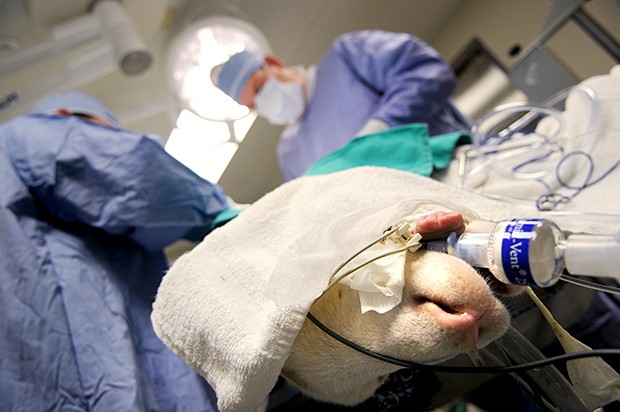In a small but brightly lit operating room, only a small patch of the patient, about six inches wide, was visible, and a casual observer probably wouldnâÄôt have noticed the hooves dangling from the end of the operating table.
Dick Bianco and his team were working to replace the patientâÄôs aortic valve Wednesday, but they werenâÄôt doing it because of heart disease or a genetic condition. Bianco heads the University of MinnesotaâÄôs experimental surgical services department, which tests new devices and techniques to ensure they are safe to be used later in humans. Sheep are used to test the aortic valves because they mimic the pattern of humans on an accelerated level, Bianco said. The procedure also meets the requirements set by the Food and Drug Administration and the National Institutes of Health âÄî if the procedure is successful in sheep it will open the door for clinical trials in humans. In six months, the 15 to 20 sheep that have undergone the surgery will be checked and have parts of the valve replaced, having mirrored five to 10 years in a human system, he said.

During the surgery, BiancoâÄôs team put the procedure on hold twice to push cold fluids down the coronary artery every 20 minutes in order to help keep the heart preserved while the body was on bypass. The hour-long procedure climaxed with the patientâÄôs heart restarting after being brought off bypass âÄî the heart-and-lung machine that pumped blood during the surgery. Where âÄúheart surgery really was inventedâÄù Still smarting from nearly $1 million in losses after a break-in by animal rights extremists in 1999, BiancoâÄôs laboratory stresses security and the important role the animals play in ensuring the safety of human subjects in clinical trials. The department has developed or tested most of the heart valves currently in use today, he said. âÄúItâÄôs a laboratory where 40, 50 years ago, heart surgery really was invented in,âÄù Bianco said. âÄúIts main role is to teach residents and faculty, explore new surgical therapies and techniques, and to look at new devices.âÄù

BiancoâÄôs work specifically focuses on cardiac procedures, like the aortic valve replacement. The aortic valve is located between the aorta and the left ventricle of the heart and pumps oxygenated blood to the rest of the body. Larry Blankenship, CEO and chairman of ValveXchange, Inc., the company that developed the new valve Bianco implanted Wednesday, said he specifically chose the UniversityâÄôs lab because of their history with testing heart valves for use in clinical trials. The new valve aims to offer another option to patients in need of a new aortic valve. Currently, he said, younger patients are usually given a mechanical valve which requires a lifetime of anti-coagulation medications (blood thinners), and as a result, a sedentary lifestyle. Older patients usually choose a tissue valve, either a porcine or bovine valve.

But the tissue valves tend to wear out in 10 to 15 years, requiring subsequent surgeries, which get riskier each time. About 300,000 to 350,000 heart valves are replaced each year, Blankenship said, and more than half are aortic valve replacements. The new valve, which recently won a âÄúTechnology Innovation of the YearâÄù award from California-based Frost and Sullivan, has a permanent base that connects to a tissue âÄúleafletâÄù that can be replaced through a minimally invasive surgery, rather than the more dangerous open heart surgery, Blankenship said. The surgery Wednesday was performed by cutting an opening into the aorta then making a ring of stitches where the new valve would sit. Bianco then parachuted the base of the valve down the strings and sewed it into place before setting the new valve leaflets. Peggy Norris, the labâÄôs manager, said the sheep would be able to sit up with its legs curled underneath the same day of the surgery and stand up by the next day.

The labâÄôs work with animals is âÄúheavily watched and regulated,âÄù she said. The University also has a team that sees research animals through their post-operation care and recovery, she said. After about a week or so of recovery, the patient would be moved to the UniversityâÄôs recovery farm, she said. Bianco said a number of sheep will also be implanted with a control device, or a valve thatâÄôs already FDA-approved, so they can compare the progress of the new-valve sheep to those with the control. âÄî Emma L. Carew is a senior staff reporter.



